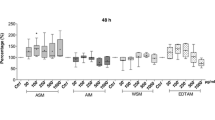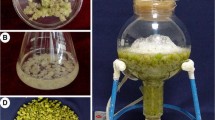Abstract
Orostachys cartilaginous A. Bor. is a high-value medicinal plant, whereas flavonoids are important secondary metabolites. Bioreactor cell culture is an alternative method for the mass production of flavonoids in O. cartilaginous. This study investigated the adaption of culture conditions using bioreactors with different sizes to provide a reference for the pilot-scale culture of O. cartilaginous cells in the future. Results showed that cell fresh and dry weights per culture medium among the balloon-type airlift bioreactors of 3, 5, and 10 L did not change. Moreover, approximately equal amounts of total flavonoids were synthesized in bioreactors with different sizes, indicating that the culture conditions optimized in a bioreactor of certain size can be used in bioreactors of other sizes. This study used methyl jasmonate (MeJA) as an abiotic elicitor to treat 25-day-old O. cartilaginous cells, and an event whether nitric oxide (NO) was involved in flavonoid synthesis in MeJA-induced flavonoid synthesis was investigated to improve flavonoid accumulation. The contents of total flavonoids and flavonoid monomers including quercetin, kaempferide, epicatechin gallate, quercetin-3-O-glucose, and kaempferol-3-rutinoside, were significantly improved by MeJA treatment, reaching the maximum value at 48 h after elicitation. During the MeJA elicitation, NO burst in the early stage and NO content peaked at 6 h. In addition, nitrate reductase (NR) inhibitors of tungstate and glutamine blocked NO generation and inhibited flavonoid synthesis in MeJA-stimulated cells. However, such inhibition of flavonoid synthesis was relieved by a NO donor (sodium nitroprusside), thereby suggesting that NO was involved in MeJA-induced flavonoid synthesis through NR pathway. The present finding has a critical significance for understanding the mechanism of the defense response stimulated by the MeJA elicitor and can provide a new strategy that regulates NO burst and flavonoid synthesis by controlling the NR activity.






Similar content being viewed by others
References
Baldi A, Srivastava AK, Bisaria VS (2009) Fungal elicitors for enhanced production of secondary metabolites in plant cell suspension cultures. In: Varma A, Kharkwal AC (eds) Symbiotic Fungi, Soil Biology. Springer Verlag, Berlin, pp 373–380
Delledonne M, Zeier J, Marocco A, Lamb C (2001) Signal interactions between nitric oxide and reactive oxygen intermediates in the plant hypersensitive disease resistance response. Proc Natl Acad Sci USA 98:13454–13459
Efferth T (2019) Biotechnology applications of plant callus cultures. Engineering 5:50–59
Foissner I, Wendehenne D, Langebartels C, Durner J (2010) In vivo imaging of an elicitor-induced nitric oxide burst in tobacco. Plant J 23:817–824
Gao FK, Ren CG, Dai CC (2012) Signaling effects of nitric oxide, salicylic acid, and reactive oxygen species on isoeuphpekinensin accumulation in Euphorbia pekinensis suspension cells induced by an endophytic fungal elicitor. J Plant Growth Regul 31:490–497
Georgiev MI, Weber J, Maciuk A (2009) Bioprocessing of plant cell cultures for mass production of targeted compounds. Appl Microbiol Biotechnol 83:809–823
Gupta NS, Banerjee M, Basu SK, Achaya K (2013) Involvement of nitric oxide signal in Alternaria alternata toxin induced defense response in Rauvolfia serpentina Benth. ex Kurz calli. Plant Omics 6:157–164
Hn M, Georgiev MI, Kim YS, Jeong CS, Kim SJ, Park SY, Paek KY (2014) Ginsenosides: perspective for sustainable biotechnological production. Appl Microbiol Biotechnol 98:7319–7329
Hu X, Neill S, Cai W, Tang Z (2003) NO-mediated hypersensitive responses of rice suspension cultures induced by incompatible elicitor. Chin Sci Bull 48:358–363
Jiang XL, Piao XC, Gao R, Jin MY, Jiang J, Jin XH, Lian ML (2017) Improvement of bioactive compound accumulation in adventitious root cultures of an endangered plant species, Oplopanax elatus. Acta Physiol Plant 39:226–235
Kang SM, Min JY, Kim YD, Kang YM, Park DJ, Jung HN, Kim SW, Choi MS (2006) Effects of methyl jasmonate and salicylic acid on the production of bilobalide and ginkgolides in cell cultures of Ginkgo biloba. Vitro Cell Dev Biol Plant 42:44–49
Lee EJ, Park SY, Paek KY (2014) Enhancement strategies of bioactive compound production in adventitious root cultures of Eleutherococcus koreanum Nakai subjected to methyl jasmonate and salicylic acid elicitation through airlift bioreactors. Plant Cell Tiss Organ Cult 120:1–10
Li CF, Wang SH, Li DH (2015) Antioxidant activities from Orostachys cartilaginous extracts. Food Sci Technol 40:285–288
Li X, Zhang L, Ahammed GJ, Li ZX, Wei JP, Shen C, Yan P, Zhang LP, Han WY (2017) Nitric oxide mediates brassinosteroid-induced flavonoid biosynthesis in Camellia sinensis L. J Plant Physiol 214:145–151
Lu D, Dong JF, Jin HH, Sun LN, Xu XB, Zhou T, Zhu Y, Xu MJ (2011) Nitrate reductase-mediated nitric oxide generation is essential for fungal elicitor-induced camptothecin accumulation of Camptotheca acuminata suspension cell cultures. Appl Microbiol Biotechnol 90:1073–1081
Mendoza D, Cuaspud O, Arias JP, Ruiz O, Arias M (2018) Effect of salicylic acid and methyl jasmonate in the production of phenolic compounds in plant cell suspension cultures of Thevetia peruviana. Biotechnol Rep 19:e00273–e00273
Modolo LV, Cunha FQ, Braga MR, Salgado I (2002) Nitric oxide synthase-mediated phytoalexin accumulation in soybean cotyledons in response to the Diaporthe phaseolorumf. sp. meridionalis Elicitor. Plant Physiol 130:1288–1297
Mostofa MG, Fujita M, Tran LSP (2015) Nitric oxide mediates hydrogen peroxide- and salicylic acid-induced salt tolerance in rice (Oryza sativa L.) seedlings. Plant Growth Regul 77:265–277
Murashige T, Skoog F (1962) A revised medium for rapid growth and bioassays with tobacco tissue cultures. Physiol Plant 15:473–497
Piao XC, Zhang WB, Jiang J, Jin YH, Park PJ, Kim SE, Lian ML (2017) Cell suspension culture of Orostachys cartilaginous in bioreactor systems for bioactive compound production and evaluation of their antioxidant properties. Acta Physiol Plant 39:70–79
Shan C, Yang T (2017) Nitric oxide acts downstream of hydrogen peroxide in the regulation of ascorbate and glutathione metabolism by jasmonic acid in Agropyron cristatum leaves. Biol Plant 61:779–784
Thanh NT, Murthy HN, Paek KY (2014) Ginseng cell culture for production of ginsenosides. In: Paek KY, Murthy HN, Zhong JJ (eds) Production of biomass and bioactive compounds using bioreactor technology. Dordrecht, New York, pp 121–142
Wang JW, Wu JY (2004) Involvement of nitric oxide in elicitor-induced defense responses and secondary metabolism of Taxus chinensis cells. Nitric Oxide Biol Chem 11:298–306
Wang JW, Wu JY (2005) Nitric oxide is involved in methyl jasmonate-induced defense responses and secondary metabolism activities of Taxus cells. Plant Cell Physiol 46:923–930
Wang J, Zhang J, Gao WY, Wang Q, Yin SS, Liu H, Man SL (2013) Identifi cation of triterpenoids and flavonoids, step-wise aeration treatment as well as antioxidant capacity of Glycyrrhiza uralensis Fisch. cell. Ind Crops Prod 49:675–681
Wang J, Qian J, Yao LY, Lu YH (2015) Enhanced production of flavonoids by methyl jasmonate elicitation in cell suspension culture of Hypericum perforatum. Bioresource Bioproc 2:5–13
Xu MJ, Dong JF (2005) Elicitor-induced nitric oxide burst is essential for triggering catharanthine synthesis in Catharanthus roseus suspension cells. Appl Microbiol Biotechnol 67:40–44
Xu MJ, Dong JF, Zhu MY (2005) Nitric oxide mediates the fungal elicitor-induced hypericin production of Hypericum perforatum cell suspension cultures through a jasmonic-acid-dependent signal pathway. Plant Physiol 139:991–998
Xu MJ, Dong JF, Zhang XB (2008) Signal interaction between nitric oxide and hydrogen peroxide in heat shock-induced hypericin production of Hypericum perforatum suspension cells. Sci China 51:676–686
Yamasaki H, Sakihama Y (2000) Simultaneous production of nitric oxide and peroxynitrite by plant nitrate reductase: in vitro evidence for the NR-dependent formation of active nitrogen species. Febs Lett 468:89–92
Yamasaki H, Sakihama Y, Takahashi S (1999) An alternative pathway for nitric oxide production in plants: new features of an old enzyme. Trends Plant Sci 4:128–129
Zhang WB, Piao XC, Wu CH, Li JR, Jin YH, Lian ML (2017) Optimized culture medium for the production of flavonoids from Orostachys cartilaginea V.N. Boriss. callus cultures. Vitro Cell Dev Biol Plant 53:1–11
Zhou BY, Guo ZF, Xing JP, Huang BR (2005) Nitric oxide is involved in abscisic acid-induced antioxidant activities in Stylosanthes guianensis. J Exp Bot 56:3223–3228
Acknowledgements
This work was supported by the National Natural Science Foundation of China (31660080).
Author information
Authors and Affiliations
Corresponding authors
Additional information
Communicated by H. Peng.
Publisher's Note
Springer Nature remains neutral with regard to jurisdictional claims in published maps and institutional affiliations.
Rights and permissions
About this article
Cite this article
Hao, YJ., Cui, XH., Li, JR. et al. Cell bioreactor culture of Orostachys cartilaginous A. Bor. and involvement of nitric oxide in methyl jasmonate-induced flavonoid synthesis. Acta Physiol Plant 42, 9 (2020). https://doi.org/10.1007/s11738-019-3008-5
Received:
Revised:
Accepted:
Published:
DOI: https://doi.org/10.1007/s11738-019-3008-5




